| کد مقاله | کد نشریه | سال انتشار | مقاله انگلیسی | نسخه تمام متن |
|---|---|---|---|---|
| 59117 | 1419438 | 2014 | 22 صفحه PDF | دانلود رایگان |
Ammonia synthesis catalyst found by Haber-Bosch achieves its history of 100 years. The current understanding and enlightenment from foundation and development of ammonia synthesis catalyst are reviewed, and its future and facing new challenge remained today are expected. Catalytic ammonia synthesis technology has played a central role in the development of the chemical industry during the 20th century. During 100 years, ammonia synthesis catalyst has come through diversified seedtime such as Fe3O4-based iron catalysts, Fe1-xO-based iron catalysts, ruthenium-based catalysts, and discovery of a Co-Mo-N system. Often new techniques, methods, and theories of catalysis have initially been developed and applied in connection with studies of this system. Similarly, new discoveries in the field of ammonia synthesis have been extended to other fields of catalysis. There is no other practically relevant reaction that leads to such a close interconnection between theory, model catalysis, and experiment as the high-pressure synthesis of ammonia. Catalytic synthesis ammonia reaction is yet a perfect model system for academic research in the field of heterogeneous catalysis. Understanding the mechanism and the translation of the knowledge into technical perfection has become a fundamental criterion for scientific development in catalysis research. The never-ending story has not ended yet. In addition to questions about the elementary steps of the reaction and the importance of the real structure and subnitrides for the catalyst efficiency, as well as the wide-open question about new catalyst materials, there are also different challenges thrown down by theory for the experimentalist in the prediction of a biomimetic ammonia-synthesis path at room temperature and atmospheric pressure including electrocatalysis, photocatalysis and biomimetic nitrogen fixation.
Graphical AbstractThe achievement and progress of the ammonia synthesis catalysts in theory and practice during about 100 years, and a new challenge in face of a biomimetic ammonia-synthesis path at room temperature and atmospheric pressure, including electrocatalysis, photocatalysis and biocatalysis, are presented. Understanding the mechanism and the translation of the knowledge into technical perfection has become a fundamental criterion for scientific development in catalysis research.Figure optionsDownload as PowerPoint slide
Journal: Chinese Journal of Catalysis - Volume 35, Issue 10, October 2014, Pages 1619–1640
